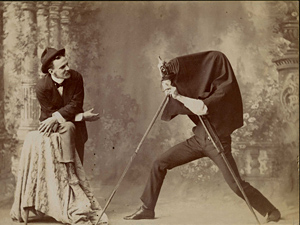The launch of the Digital Public Library of America brings greater access to local treasures.
History became easier for the nation and the world to access, thanks to the recent launch of the Digital Public Library of America (DPLA).
The DPLA is a groundbreaking project that, for the first time, will make many of America’s significant digital collections searchable and accessible to the public from a single site. It will aggregate millions of digital artifacts from local archives, libraries, museums, and cultural heritage institutions across America and deliver them to students, teachers, scholars, and the public via a powerful search interface.
The University of Minnesota played a key role in the statewide collaboration to assist in the launch of the massive online library, providing the expertise to digitize many of the materials and make them searchable.
Millions of artifacts

In this photo from the Blue Earth County Historical Society, Dr. G. A. Dahl from Mankato poses with a photographer. Estimated year: 1900. Image credit: University of Minnesota
Planning for the DPLA began in October 2010; several states launched pilot projects this past April.
With total funding to date of about $7.8 million, the DPLA brings together a national network of more than 40 state/regional digital libraries and myriad large digital libraries. These include large “content” hubs, such as The Smithsonian Institution, and state and regional “service” hubs, such as the Minnesota Digital Library.
The Minnesota Digital Library (MDL) received $350,000 in funding for digitizing existing special collections, making them searchable and accessible through the DPLA. The funds also provided outreach and education to communities about the DPLA, supported the development of new, “born digital” content, and captured the unique and diverse stories of the communities throughout the state and region.
The MDL is supported through a statewide collaboration of Minitex, the University of Minnesota, the Minnesota Historical Society, and other key institutions. In its role as a DPLA hub, the MDL will serve as an “on-ramp” to interested public libraries, special libraries, colleges, museums, historical societies, and other organizations across the state—ensuring that local and regional collections throughout Minnesota can be discovered and accessed through the DPLA as part of this new national initiative.
“We are very excited about this project,” says John Butler, associate librarian at the U of M Libraries. “Not only will we be able to digitize existing local content and make it accessible across the country, but [DPLA] will help empower communities to share their rich histories in new ways.”
Through a project called Minnesota Reflections, MDL began digitizing content in 2004. Today it contains over 120,000 images, maps, and documents from nearly 150 of the state’s libraries and cultural heritage organizations.
Marian Rengel, MDL outreach coordinator, travels the state to meet with these organizations and assists them in sharing their history through the digitization and inclusion of their unique collections in Minnesota Reflections.
“We have been, for 10 years now, about access, helping organizations around the state share what they have. And this will give us a chance to share on a national platform,” says Rengel. “It will give people across the country a sense of how Minnesota fits in with the story of America.”
Community engagement
Overall, DPLA will be a major benefit, not just to scholars, but to the general public.
“We’re looking to provide the DPLA with [the ability] to go out and engage the community and create new kinds of digital documentation—be they audio storytelling or oral histories, documentary photography, perhaps even documentary video,” says Jason Roy, director of Digital Library Services at the U of M Libraries and the project manager for the MDL-DPLA collaboration.
“The DPLA allows us access to an incredible set of unique digital collections,” he says.
“[Now] we can begin to weave together a national story…gathered from across this great nation.”
*Source: University of Minnesota
